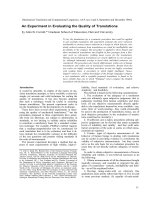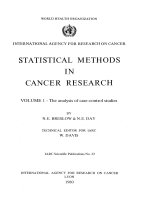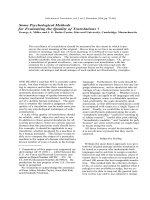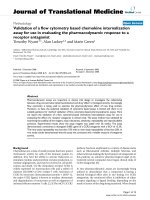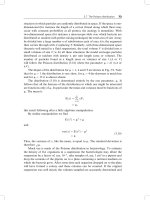Researchingapplications of statistical methods in evaluating the quality of services of Vietnamese commercial banks - Illustrations through a specific research at the Joint Stock Commercial Bank
Bạn đang xem bản rút gọn của tài liệu. Xem và tải ngay bản đầy đủ của tài liệu tại đây (112.02 KB, 16 trang )
INTRODUCTION
1. The reasons of choosing the thesis
In the process of economic integration, how the increasing competition will affect the banking
sector depends in part on the adaptability and the quality of service (QoS) of banks themselves.
In recent years, aware of the raising role of QoS of banks, many scientists in the field of Banking
in Vietnam has organized many researches on this issue. These studies mentioned on identifying
approaches of the content reflecting QoS of banks and evaluation methods of content that reflects the
QoS. Each study has a different identify of QoS, but they are based on quality models that has been
studied such as a model of SERVQUAL (Service Quality), a model of Function and Technical Service
Quality (FTSQ), a BANKSERV model (Bank Service) ... The assessment methods of QoS, that previous
studies use, are mostly an analysis of the primary component, multiple regression analysis and a
combination of this two method in structural modeling methods SEM (Structural Equation modeling).
The studies have advantages that they have identified the content that reflects the quality and evaluate the
correlation between the content reflecting QoS and customer satisfaction when using banking services.
However, these earlier studies did not realize that despite of the advantages, the models of QoS
has some drawbacks as inconsistent measure contents of QoS, the comparison between perceived and
expected QoS is very difficult to determine accurately, or many measurement contentsQoS are almost
identical... Moreover, in the study of QoS, sometimes, bank managers not only want to recognize the
content reflecting QoS, determine the correlation between the content that reflects QoS and customer
satisfaction, but also want to identify the correlation by visual image and recognize the orders of priority
improvements for contents reflecting QoS. Research methodology of the correlation with the visual image
has benefits to easily recognize the relationship intuitively and the ability to add extra elements (being
individuals as a new bank, new banking services or new variables) to purpose of helping the comparison
between a new individual and an old individual in the correlation with the parameters of the quality of
services. This is the content that the thesis will target.
With the aim of enhancing the technical application of statistical methods for the quality of banking
services, I have chosen the thesis: "Researchingapplications of statistical methods in evaluating the
quality of services of Vietnamese commercial banks - Illustrations through a specific research at the
Joint Stock Commercial Bank of Investment and Development of Vietnam (BIDV)".
This thesis will provide an overview of the quality of banking services and the ability of application
combining with statistical techniques to assess QoS of commercial banks in general and the Joint Stock
Commercial Bank of Investment and Development of Vietnam in particular.
2. The aims of research
- Overall aim: Researching techniques forapplying of statistical methods in evaluating QoS, then
proposing a plan to investigate QoS of commercial banks in general and the Joint Stock Commercial
Bank of Investment and Development of Vietnam (BIDV) in particular.
- Particular aim:
+ Constructing research models and building a process of assessment QoS for BIDV.
+ Researching techniques for using a combination of statistical methods for a purpose of
studyingthe multi-dimensional relationship of QoS and segmenting customer using banking services.
+ Determining the contribution of service quality indicators to customer satisfaction and the orders
of priority improvementQoS of BIDV.
3. Object and scope of the research
- Object: the researching object of dissertation is the statistical methods in the assessment QoS of
banks.
- Scope: The thesis only focuses on the quality of banking services following the view of customers
(which does not mention the concept of QoS standing on the supplier perspective). The survey data
illustrates the research limited to objects that are individual customers using the service at some branches
of BIDV in Hanoi.
4. Research Methodology
Thesis uses a combination of statistical methods below:
- Methods of analyzing available information.
- Methods of expert.
- Methods of statistical surveys.
- Methods of descriptive statistics.
- Methods of quantitative analysis.
5. The contributions of the thesis
The thesis has made the following contributions:
- Develop models including appropriate indicators to measure QoS and customer satisfaction in
the Joint Stock Commercial Banks in Vietnam in general and the BIDV in particular.
- Develop the measure process and assessmentthe quality of banking services.
- Purposed applications combining with methods of multidimensional statistical analysis in
evaluationthe quality of banking services: (1) analyzing two-step cluster (applied to the mixed data
including quantitative and qualitative data) to segment customers; (2) analyzing key components to find
the basic component of QoS; (3) analyzing multiple correspondence to represent visually the relationship
between QoS with the type of service and client groups.
- Apply the evaluation method of capacity of Provincial Competitiveness (PCI-2012) to
determine the orders of priority improvements QoS.
6. Structure of the thesis
Besides the introduction and conclusion, the main content of the thesis consists of four chapters:
Chapter 1: Several common issues of measurement the quality of banking services
Chapter 2: Several statistical methods of assessing the quality of banking services
Chapter 3: The situation of assessing the quality of services in the Joint Stock Commercial Bank
of Investment and Development of Vietnam.
Chapter 4: Application of some statistical methods in evaluating the quality of banking services in
the Joint Stock Commercial Investment and Development of Vietnam.
CHAPTER 1
SOME GENERAL ISSUES ON MEASUREMENT OF
THE QUALITY OF BANKING SERVICES
The content of this chapter focuses on introducing general theoretical issues related to measure
the quality of banking services.
1.1 General theory of banking services
In Vietnam, the Law on Credit Institutions in 1997, the term of "banking services" were also
mentioned in Clause 1 and Clause 7 of Article 20, but not having a specific definition and clearly
distinction of what banking services is are no formal concept. There are many suggestions that all the
operations of joint stock commercial banks (credit operations, currency, forex ...) are regarded as banking
services. This view is consistent with the view of the world that defines "banking services are
understoodgenerally to include all the operations of the bank for the public and businesses."
Banking services have the basic characteristics: (1) Invisibility; (2) Simultaneity; (3) Instability
and the difficulty to determine the mass; (4) Products of banking services having highly complementary;
(5) An average cost per transaction for personal customer service high; (6) Banking services for
individual customers who want to develop good technical infrastructure requiring modern technology; (7)
The need for topical points; (8) Banking serves for individual customers have the advantage of economies
by scale and scope; (9) Banking serves for individual customers are simple and easy to implement; (10)
The risks of banking services for personal customers are low.
Banking services are varied and suitable for many different types of customers (individual
customers or corporate clients). In the scope of research, the thesis only mentioned on some personal
banking services including: (1) Money Management; (2) Credit; (3) International payment: (4) Trading
currency; (5) Modern Bank.
1.2 The quality of banking services
The quality banking services is the difference between the expectations of servicing products and
the attitude of customers when using such services. This can be considered as the most general concept,
comprising of fully inclusive sense of service when considering the quality of banking services by the
view of customers regarded to be the center.
The quality banking services includesfive characteristics: (1) Excellence, (2) Characteristic of the
product, (3) Supply, (4) Satisfy of demands, and (5) Creation of value. The all five characteristics of QoS
aim to create customer satisfaction when using the service.
By the point of view that services are to server customers, considering customers as the center,
the quality banking servicescan be measured on a number of basic criteria: (1) The perfection of the
service provided; (2) The attitude and responsibility of staff providing banking services; (3) The
competitive capacity of services and diversification of services provided; (4) The difference of the service
compared with other banks.
Based on measurement criterions QoS, the researchers have developed models to measure the
quality of service in general and its application in the banking sector in particular include: (1)
SERVQUAL; (2) SERVPERF; (3 BANKSERV; (4) FSTQ. Each model has advantages and
disadvantages, so it should not apply one particular model, but selecting appropriately indicators for
research in Viet Nam market.
In this section, the PhD student also mentioned on the relationship between QoS and customer
satisfaction. Though being closely related to each other, QoS and customer satisfaction have certain
differences. The purpose of understanding these differences will help reduce confusion between the
identification of measurement criterions of QoS and the criterions reflecting customer satisfaction.
In summary, by analyzing the available documents on the measurement indicator models QoS,
the measurement indicator of customer satisfaction and consulting experts, the PhD student proposed the
measurement indicator model for the quality of banking servicesand the measurement indicator model of
customer satisfaction when using banking services. (The contents of the two models are represented in
Chapter 3).
--------------------CHAPTER 2
SEVERAL STATISTICAL METHODS TO EVALUATE
THE QUALITY OF BANKING SERVICES
The content of Chapter two introduces statistical methods of measurement and evaluation QoS
including: (1) A data collection method; (2) A data aggregation method; (3) A data analysis method.
2.1. A data collection method
In this section, the PhD student focuses on a general introduction to some methods to collect data
(directly or indirectly) with the data collection technique (facing interview, writing interview, mobile
interview, group interview, observation techniques and analysis of available data) ... Based on that, the
PhD student introduced methods of collecting data that can be applied in researching the quality of
banking services which includes collection methods with directly facing interview techniques standard,
mobile interviews or group interviews combined with technical observation, taking notes.
2.2. A data aggregation method
After performing data collection, it needs to conduct processing data before putting in the
analysis of that data. A mechanism of processing statistical data comprises of data test, data correction,
data encryption, data entry, data description that are called statistical aggregation.
First, checking the data to examine the reasonableness and completeness of data in terms of form,
content or check the reliability of measurement ...
Second, the data after being checked and cleaned (corrected data) will be encrypted. Testing of
data after coding is usually done through building diagonal tables or stem - leaf diagrams, box-plot graphs
…
Third, the data after being encrypted can be expressed in technical classifications, tables and
graphs.
2.3. A data analysis method
There are many methods of analyzing data such as analyzing variance, regression ... In this part,
the thesis focuses on introducing the content and significance of the multidimensional statistical analysis
methods to evaluate QoS.
The method of multidimensional statistical analysis is the common name of a set of statistical
methods applied to sets of data consisting of a large number of original variables and the large number of
individuals (the observer).
Multidimensional analysis methods include methods of group factor analysis and methods of
classification.
(1) A group of factor analysis methods include:
Principal component analysis: the number of measurement criterions QoS is large, so
using analytical methods to extract key components of data is necessary
Multiple Correspondence Analysis: this method is used to locate the service products in
the correlation with QoS components and customer segments
(2) The cluster analysis method: to analyzing the quality of banking services, the cluster analysis
method is used to segment customers and search targeting customer groups. In the cluster analysis
method, two-step clustering method (Two steps Cluster) is the method having a high applicability in bank
because it is able to offer automatic clustering results for the mixed data (including data qualitative and
quantitative data)
Thus, the method of exploiting data, the exploitation of information and showing different basic
outcomes of these two groups of methods, the PhD student aims toward to the ability of application that
combines these two methods to research the quality of banking servicesin particular and to describe a set
of complex data generally in society and economy.
-----------------------CHAPTER 3
THE SITUATION OF ASSESSING THE QUALITY OF SERVICES IN THE JOINT STOCK
COMMERCIAL BANK OF INVESTMENT AND DEVELOPMENT OF VIETNAM (BIDV)
Chapter three presents two mainparts:
3.1. The situation of researching the quality of services in the Joint Stock Commercial Bank of
Investment and Development of Vietnam (BIDV)
In recent years, BIDV has carried out many customer surveys including the investigation for each service
product and for each customer group. By researches on each product or each customer group, BIDV can
organize itself; but by researches integrated customer group and service products or investigating the
trademark, the BIDV must employ outside researching organizations to do.
3.1.1. For the customer survey held by the Bank itself
The personal customer survey performed by the BIDV self-organize use the following methods:
Method of information collection:the BIDV uses direct interviews through questionnaires (for
VIP customer survey group) or telephone interviews (for the mass consumer groups and
investigations of each of the service)
Method of samplechoice: the BIDV implementsa method of survey to chooserandom samples for
the investigations of each type of service products, and make a method of convenient sample
choice for the investigations of each client group
Method of data processing: A work of processing data for the surveys organized by the BIDV
includes gathering votes, checking and correcting questionnaire, encryption, entering the
information, testing and aggregating data. Data entry and coding at the Bank is done
automatically.
Method of analyzing data about QoS of individual customers at current BIDV mainly
isdescriptive statistical methods (as frequency and percentage) with tables and graphs.
3.1.2. For customer surveys implemented by outsources that BIDV employs:
With the customer survey project on a large scale as a trademark investigation, the investigation
combined customers with service groups, the BIDV often employ outside organizations to perform. With
these projects,the BIDV will conduct monitoring the implementation process. For this investigation, the
organization of surveys will provide final results for the BIDV. Specifically, in the survey of 2014, the
BIDV hired Nielsen to investigate on the evaluation of the BIDV's customers with QoS and compare with
other banks. This investigation has the advantage of using different attributes to measure the quality of
different types of services. This helps to assess the details of each type of services. However, the
disadvantage is to be unable to compare with other types of services at the same quality characteristic.
Therefore: (1) when to compare the type of service you should use identical the measurement
characteristics of QoS; (2) to evaluate details of customer comments for each specific service, it can use
particular characteristicsof each service.
3.2. General comments on the current situation of the eluvation in the BIDV’S QoS
Through studying the status of the QoS evaluation process of BIDV now, this process still exist
the following limitations:
- First, restrictions on information gathering methods:
- Second, the restrictions on the scale:
- Third, the restrictions on the questionnaire:
- Fourth, restrictions on methods of analysis
In summary, through field surveys and consultation with experts in the field of banking and
statistics, this thesis build new processes to assess service quality at BIDV.
3.3. Develop new processes for BIDV in evaluating QoS
Based on assessment of the advantages and disadvantages of the research process on QoS at the
BIDV now, the thesis proposed to construct a new research process on QoS include the following steps:
+ Qualitative analysis: to find models of QoS measurement indicators and models of
measurement indicators for customer satisfaction (Table 3.1).
+ Design the questionnaire: to include the content for clustering customers; QoS measurement
indicators, the indicators that measure customer satisfaction.
+ Select of sampling methods and collecting information: a method of information collection can
be used is to collect directly through questionnaire. Sampling method should be based on the structure of
the sample similarity with the general structure form follow a certain criteria. Specific, the thesis uses the
overall structure with anoccupational criterion to build the structure of the sample.
+ Select the method of information analysis: using multidimensional statistical analysis.
This process will help the BIDV to undertake research QoS actively and ensure the reliability of data and
methods of analysis.
Table 3.1 - Models QoS measurement indicators and customer satisfaction
Model
Component
Convenience
The quality of
services
Customer
satisfaction
QoS measurement indicators
TT1- Banks have convenient locations of transactions for
TT2- Banks have the wide network of agencies
TT3- Timing services of banks are suitable and
TT4- Systems to access information are easy to use
TT5- Transaction procedures are easy and quick
HH1- Banks has equipment and modern machines
Tangle
HH2- Banks has a very nice layout
HH3- Banks has the documents, books and photos introducing this service very attractive
HH4- Banks has the explicit transaction documents with no mistakes
HH5- Bank employees dress polite and impressive
HH6- Banks have full facilities
PC1- Bank employees resolve satisfactorily for customer complaints
Stylish
services of PC2- Bank employees has professional qualifications
PC3- Bank employees perform services accurately and timely
staff
PC4- Bank employees are ready to server customers Nhân viên NH rất sẵn sàng phục vụ
khách hàng
PC5- Bank employees are very courteous and attentive to customers
TXKH1- Bank employees often contacts with customers
Interaction
TXKH2- Banks organize banquet thank or reward programs for customers every year
with
TXKH3- Banks has hotline to service customers for 24 hours
customers
TXKH4- Banks always listens to opinions of customers
TN1- Banks protects customer information and transactions
The Trust
TN2- Banks performs services right from the first time
TN3- Banks sends account statement regularly and timely
Time for customers to use banking services
The number of services that customer are usingat banks
Whether customers are willing to go to the bank in the future (continuing to perform transactions at banks)
Customers introduce banksto others
Levels of general satisfaction with the quality of banking services
On the basis of this study on QoS, chapter 4 introduces a studying sample that the thesis has made
the investigation according to the right process and this sample will be tested to apply some statistical
methods in the next chapter.
---------------------------Chapter 4
APPLICATIONS SOME STATISTICAL METHODS IN EVALUATION OF QUALITY
SERVICES OF THE JOINT STOCK COMMERCIAL BANK OF INVESTMENT AND
DEVELOPMENT OF VIETNAM
The content of chapter four presents a potential application of statistical methods in evaluating
QoS with a sample data that is investigated at the BIDV. Scope of research only refers to assess QoS for
individual banks and properties of QoS measure built on the evaluating point of clients (not evaluate QoS
based on the perspective of the provider service). In terms of analysis, chapter four will focus on
introducing the ability to apply statistical methods of multidimensional analysis to evaluate QoS.
4.1. About the sample
According to the comments of the experts, authors choose to define form-based study "sample
structures are similarity to the structure of the overall following a criterion." However, according to the
statistical results of the BIDV bank, customer structures are generally classified by many different
criterions such as occupation, education and income. In the scope of the thesis, the author selected
distribution sample structure by theoccupational criterion (because this is the criteria helping to create a
pattern that matches the overall follow the remaining criteria of education and income).
The thesis uses convenient sampling method with individual customers using the services of the
BIDV. After sending 300 questionnaires, the thesis earned 250 valid votes. In the 250 customers
surveyed, there are customers who use more than one service. By the sample of 250 customers, the thesis
checks the satisfaction of each customer for each type of service and storing data of a client for a service
type as an independent individual. The results are from 250 customers distributed by type of using service
to become 363 independent individual.
4.2. Assessing the quality of service at the BIDV
The orders of assessment QoS at the BIDV is performed as following:
4.2.1. Applying techniques clustering of Twosteps-Cluster to segment customers using the services of
the BIDV
Use this clustering technique for a data set including qualitative and quantitative variables.
Results from clustering customers are to divide clients in the sample into three groups:
+ Group1: customer group with low status.
+ Group 2: customer group with high status.
+ Group 3: group of loyal customers.
4.2.2. DeterminingQoS components
To determine the QoS components, the thesis conducts in two steps: (1) Check the reliability of
the indicator measurement of QoS (by the method of calculating the coefficient Cronbach's alpha) and (2)
identify the major components of QoS (by method of main component analysis -PCA)
The indicator model of QoS bank bases on originally analysis results composed of 23 indicator
parameters. After examination the reliability by Cronbach alpha, 2 indicators are disqualified. Therefore,
there is remaining of 21 indicators being put in the PCA main component analysis to assess the degree of
convergence of indicator parameters according to the components.
Analyzing main components for the first time leads to results that remove 4 variables unsatisfied.
The model of measurement QoS remains 17 indicators and these 17 indicators will be used to analyze
main components for the second time. The results showed 17 indicator parameters that are extracted into
4 main components with the total variance extracted for 4 main components (with eigenvalues greater
Eigenvalue 1) is 59.802% of satisfaction:
* Style component and customer contacting capabilities includes: TXKH2; TXKH1; TXKH3;
PC5; PC1; PC3
* Tangible component includes HH4; HH3; HH1; HH5; HH6
* Trust component includes TN2; TN3; TN1.
* Convenient component includes TT2; TT3; TT4.
4.2.3. Re-encrypt the data for service quality components
To encode the Factorscore values of main quality components corresponding with 2 values:
satisfaction (Factorscore> 0) and dissatisfied (Factorscore <0) with QoS components, should be based on
the results of the distribution of Factorscore values following the variables belong to that QoS component.
Results are shown in the chart Boxplot.
4.2.4. Evaluation QoS of the BIDV
To assess QoS of the BIDV, the thesis uses multiple correspondence analysis - MCA. In MCA
analysis, customer segmentation variable (as a result of clustering above) is regarded as an additional
variable (i.e. not affect the results of the analysis variable). Simultaneously, based on MCA, all the
possible answers of the main variables and additional variables are presented in an optimal subspace. The
analyzing results are shown on 2 contents:
4.2.4.1. The quality of all types of services.
To research the quality of the 5 types of services are specified in the relationship between the
main 4 of QoS (was extracted and coded above) and 5 types of services (QLT, TD, TTQT, KDTT ,
NHHD) through cognitive maps following three directions:
• The first is to feel about the 5 types of services according to each component QoS:
Figure 4.1 - Map of correspondence between the QoS components and services
Figure 4.1 shows that:
- Money Management Services (QLT) and Currency Trading (KDTT) is generally evaluated to be
convenient, and satisfy the demand of trust from customers and meet the satisfaction of ability for
contacting with customers. These two types of services meet all 4 QoS components.
- Credit Service (TD) and International Payment (TTQT) are estimated to be untruth, not tangible,
not convenient and a poor style of interacting customers.
- Modern Banking Services (NHHĐ) have a good evaluation from tangible components and gain
the trust of customers, but they are not convenient for the customer and the ability to interact with
customers is not good.
• Second: Compare the services on each component quality
Results from comparing the type of service are explained by that two types of services are more
closer to each other on a map to show that the customer's perception of this two type are more the same
on all the QoS components being considered .
Considering the tangible component and Trust, modern banking services are rated higher service
Currency Trading.
For Convenient components, money management services are the most appreciated.
Considering the level of the trust and tangible, both international payment service and credits
were not achieved but credit is still rated better than international settlements (meaning that level of
untruth of Credit lower)
• Third: Positioning the group of customers in the space of quality service components.
Positioning the client groups on the plane (created by 2 axes extracting from the variable
component QoS) to examine the assessment of the client group with 4 QoS components and 5 types of
services
Figure 4.1 shows that group customer 1 and 2 often use credit and international payment services
of the BIDV in all customers using the services of the BIDV. Therefore, the preferred choice of targeting
customer group of BIDV is group 2, Service and Billing Credit International need to appropriately
improve to meet requirements of QoS.
4.2.4.2. The quality of each type of service.
Based on the distribution of individual customers on the retail banking market into segments with
characteristics of each segment, the thesis uses MCA method to determine the correspondence between
the QoS components with the individual customer segment in each type of service.
Results aggregates for analysis of each type of service as follows:
+ Group 1 evaluated the types of services are almost not tangible, not convenient, low style and
interacting (except for international payment services), so it is no trust with almost types of services
(excluding money management services).
+ Group 2 did not evaluate well on the quality of the 4 components for five types of services
(except the trust with money management services).
+ Group 3 rated good for most of the types of services (except evaluation International Payment
Services are bad to contact and not trust for money management services).
4.3. Assessing the impact of these QoS components and determine the orderss of priority
improvement.
To assess the influence of these QoS components and to determine the orders of priority
improvements QoS, the thesis uses the method for calculating the coefficient of the provincial
competition. The orders of performance shall be done as following:
Step 1: Select and compute components the quality of banking services
This content has been implemented by the method of main component analysis above and has
drawn four main components reflecting the quality of banking services. Four QoS components are no
correspondent together
Step 2: Develop a multiple regression equation reflecting the impact of the 4 components of quality
service to the indicator reflecting the overall satisfaction of customers with QoS (5 indicators).
Step 3: Identify the contribution of four QoS components to the overall satisfaction customer
Table 4.29 – Percentage of contribution of QoS components for variables reflecting customer
satisfaction
QoS Components
Others
PC_ TXKH
HH
TN
TT
Time to use the service (TRj1)
63.23
8.909
9.169
9.054
9.637
The number of using services (TRj2)
73.86
5.774
7.334
7.594
5.436
Continuing use of services(TRj3)
23.64
17.910
17.191
20.592
20.67
Introducing banks to other persons (TRj4)
26.96
12.808
21.469
18.363
20.39
Assess levels of general satisfaction on QoS (TRj5)
63.497
8.022
9.465
9.104
9.911
Criterion
(Sources from author counting the data in the thesis)
Step 4: Determine the weight that assesses the importance of each QoS component
The weight evaluating the importance of each QoS component is calculated as an average of five
coefficients reflecting the percentage of contribution of such QoS component with 5 variables that reflect
customer satisfaction.
Table 4:30 - The weight of the components of quality service
QoS components
PC_ TXKH
HH
TN
TT
Weight (ETRj)
12.841
15.469
15.292
15.873
Step 5: Calculate the weight evaluating the importance of service quality indicators and identify the
orders of prioriy improvements QoS.
Table 4.31- identify the orders of prioriy improvements QoS of theBIDV.
Contributions
of QoS
indicators
Factor loadings
QoS measurement indicators
The orders of
prioriy
improvements
QoS
PC_ TXKH
HH
TN
TT
TXKH2- BIDV always listens to opinions of customers
0.769
0.212
0.105
0.129
14.019
7
TXKH1- BIDV employees often contacts with customers
0.749
0.082
0.338
0.125
15.088
10
TXKH3- BIDV has hotline to service customers for 24 hours
PC5- BIDV employees resolve satisfactorily for customer
complaints
PC1- BIDV employees are very courteous and attentive to
customers
0.717
0.217
0.365
-0.041
14.648
8
0.622
0.214
0.022
0.134
11.467
1
0.540
0.187
0.059
0.274
12.570
2
PC3- BIDV employees perform service accuratly and timely
HH4- BIDV has the explicit transaction documents with no
flaws
HH3- BIDV has the documents, books and photos
introducing this service very attractive
0.517
0.083
0.207
0.257
12.675
3
0.308
0.731
0.103
0.091
12.871
4
0.012
0.693
0.088
0.236
13.342
5
HH1- BIDV has equipment and modern
0.349
0.661
0.059
0.154
15.071
9
HH5- BIDV employees dressed polite and impressive
0.143
0.585
0.408
0.224
17.328
15
HH6- BIDV has full facilities
0.279
0.567
0.213
0.343
17.597
16
TN2- BIDV performs services right from the first time
0.182
0.131
0.815
0.292
18.042
17
TN3- BIDV sends account statement regularly and timely
0.195
0.053
0.757
0.342
17.083
14
TN1- BIDV protects customer information and transactions
0.284
0.338
0.755
-0.038
16.672
13
TT2-BIDV has a wide agency network
0.141
0.048
0.179
0.813
15.183
11
TT3- Timing services of BIDV is suitable and convenient
0.141
0.226
0.233
0.646
15.976
12
TT4- Systems to access information are easy to use
0.275
0.251
0.066
0.501
13.655
6
(Sources from author counting the data in the thesis)
Results from Table 4.31 reflecting the orders of QoS measuremeent indicators should innovate in
the process of the management of QoS for the BIDV. Thus, the indicator PC5 (staff resolves satisfactorily
customer complaints) are rated the lowest contribution to the satisfaction of QoS and therefore it needs to
improve the quality first. The next indicators which need to improve the quality are PC1 and PC3. This is
the question for the BIDV as it proves that the service style of bank staff is not good.
A TN2 indicator (Bank does right and correctly the services) is rated to be the best contribution
to customer satisfaction. Other indicators of Trust (TN3, TN1) are also appreciated very high. This proves
that customers appreciate high the level of trust for general services of the BIDV
Thus, according to the contributions of indicators to measure the overall satisfaction CLDV
customers, it can be seen that BIDV has gained high trust of customers. But the style service of staff is
rated very low. The BIDV bank need to have a retraining program for its staff in the service style and
contacting customers to maintain customers in the period of strong competition among banks and
financial institutions inside the country.
4.4. Proposals and recommendations
By the evaluation of each customer group and determination the level of contribution of the
indicator measuring the initial quality to overall satisfaction of customers on QoS, we can make
recommendations to the bank as following:
The first is that the BIDVbank needs to research completely the methodology of survey to collect
multi-dimensional data in the evaluation the quality of banking services. Through the survey, we found
that the current data collection methods can only apply for analyzing single data descriptions. Besides, the
bank should change the scale of assessment QoS as the thesis proposed, because it is the full scale and
ensures a comparison between the contents reflecting QoS.
Secondly, the BIDV bank should store customer profile data in detail, fully information about the
customers in the form of data both qualitative and quantitative. This mixed data will be the basis for
applying the method of clustering two steps to help perform market segmentation and find potential
customers. In the thesis, because of the possibility of time and funding should not allow, the PhD student
only collected some basic information about the client, but it is the initial contribution of methods to
process data in segmentation of mixed groups.
The third is that banks should periodically assess QoS information, may be monthly or quarterly
or before performing a new business program. The aim is to identify the orders of priorities to improve
the quality at each stage.
Fourthly, banks need to have training programs, professional training of multidimensional data
analysis for staff administration QoS and customer care. Training may include guidelines for data
collection, data entry, data analysis and reporting multidimensional periodic statistical the orders of
improvement QoS.
Fifthly, methods of multidimensional statistical analysis can be used to compare QoS of service
types between banks together. This could be a potential target of research for managing marketing in the
bank which wants to locate their services and products compared to competitors in the space comparing
the contents that reflect QoS.
The sixth is the requirements for the administration QoS of the BIDV based on data analysis of
the thesis:
+ BIDV needs to take care of improving the level of knowledge and training style contact
customers for its employees. These are factors that should be the top priority in improving QoS.
+ BIDV need to invest more for the tangible infrastructure like facilities with modern machinery
and photo and book materials introduced service and transaction documents clearly and conveniently.
+ BIDV need have private policies to maintain the target customer groups, such as customer
group has a dominant position and loyal customer groups. Customer groups which have a dominant
position (including those with high incomes, high level and high status occupations) are eligible for many
banks targeted. Without priorities and appropriately policies, BIDV will lose potential customers. For
loyal customers, the Bank needs to create confidence for them in money management services to increase
their trust on this service and will introduce the BIDV's services to others.
CONCLUSION
The QoS and customer satisfaction are the key factors to success in the business of banks and
financial institutions. With the thesis: "Researching applications of statistical methods in evaluating the
quality of services of Vietnamese commercial banks - Illustrations through a specific research at the Joint
Stock Commercial Bank of Investment and Development of Vietnam (BIDV)", the dissertation has
identified the main components of QoS and the contributions of these components to the overall
satisfaction of customers for the services that the customersare using. Based on the combined use of
statistical methods of multidimensional analysis, the thesis studies the relationship between the QoS
components and the various types of services, comparing the appreciation of customers for various types
together by positioning of the types of services in the space of measurement service. This is the
background to help managers assess the most intuitive way on the customer’s feel with the types of
service that they are using.
The thesis has toward to the ability of application some methods of multidimensional statistical
analysis of the study QoS and proposed ways of collecting as well as managing individual customer data.
This is the basis for the market segments in bank marketing activities being conducted efficiently.
Although researching results are limited to the sample, the thesis has contributed to proposethe
assessment processQoS and applications of methods multidimensional statistical analysis in researchingto
position service products of banks in the market. Methods of multidimensional statistical analysis are very
important to study quality managements in general and should be developed in the future.
LIST OF WORKSBY THE AUTHOR
Number
Title of articles
Name of seminars, magazines
Time
Scientific Conference "Development
1
2
Vietnam Bank system with social
responsibility.
of social enterprise through the
Universities of Vietnam - Challenges
08-2012
and Opportunities" - NEU
Datamining technical applications in
Journal
of
Financial
analying banking activities.
Currency - No. 15 (408)
Markets
08-2014
Application of Cluster the Twosteps
3
method to group customers using
banking services.
The
4
Journal of Banking - No. 18
Statistical
methods
examine
multidimensional in researching the
quality of banking services.
09-2014
Journal of Finance 10(600)
10-2014

